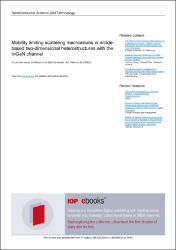Mobility limiting scattering mechanisms in nitride-based two-dimensional heterostructures with the ıngan channel

Göster/
Erişim
info:eu-repo/semantics/openAccessTarih
2010Yazar
Gökden, SibelTülek, Remziye
Teke, Ali
Leach, J. H.
Fan, Q.
Xie, J.
Lisesivdin, Sefer Bora
Morkoc, H.
Üst veri
Tüm öğe kaydını gösterÖzet
The scattering mechanisms limiting the carrier mobility in AlInN/AlN/InGaN/GaN two-dimensional electron gas (2DEG) heterostructures were investigated and compared with devices without InGaN channel. Although it is expected that InGaN will lead to relatively higher electron mobilities than GaN, Hall mobilities were measured to be much lower for samples with InGaN channels as compared to GaN. To investigate these observations the major scattering processes including acoustic and optical phonons, ionized impurity, interface roughness, dislocation and alloy disorder were applied to the temperature-dependent mobility data. It was found that scattering due mainly to interface roughness limits the electron mobility at low and intermediate temperatures for samples having InGaN channels. The room temperature electron mobilities which were determined by a combination of both optical phonon and interface roughness scattering were measured between 630 and 910 cm(2) (V s)(-1) with corresponding sheet carrier densities of 2.3-1.3 x 10(13) cm(-2). On the other hand, electron mobilities were mainly limited by intrinsic scattering processes such as acoustic and optical phonons over the whole temperature range for Al(0.82)In(0.18)N/AlN/GaN and Al(0.3)Ga(0.7)N/AlN/GaN heterostructures where the room temperature electron mobilities were found to be 1630 and 1573 cm(2) (V s)(-1) with corresponding sheet carrier densities of 1.3 and 1.1 x 10(13) cm(-2), respectively. By these analyses, it could be concluded that the interfaces of HEMT structures with the InGaN channel layer are not as good as that of a conventional GaN channel where either AlGaN or AlInN barriers are used. It could also be pointed out that as the In content in the AlInN barrier layer increases the interface becomes smoother resulted in higher electron mobility.

















